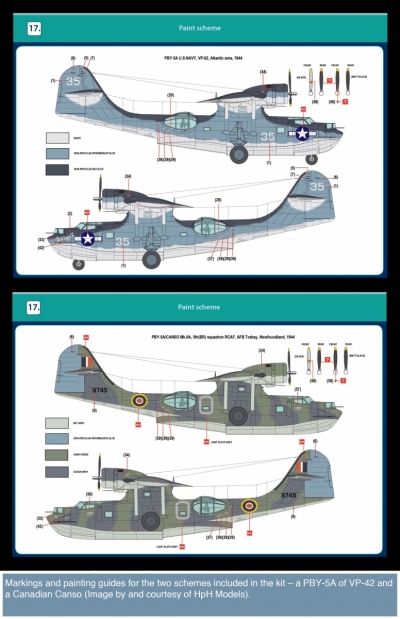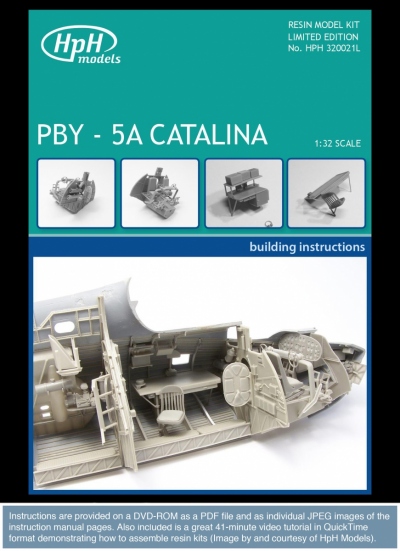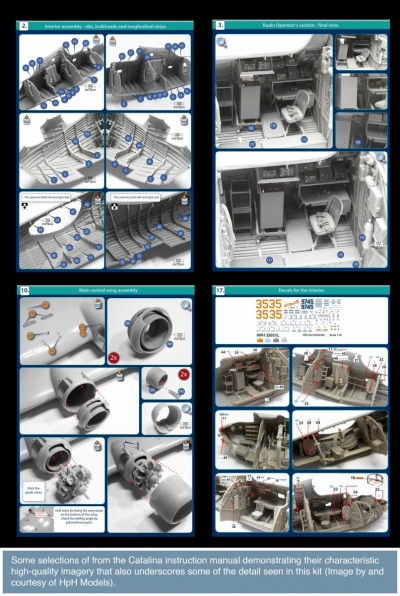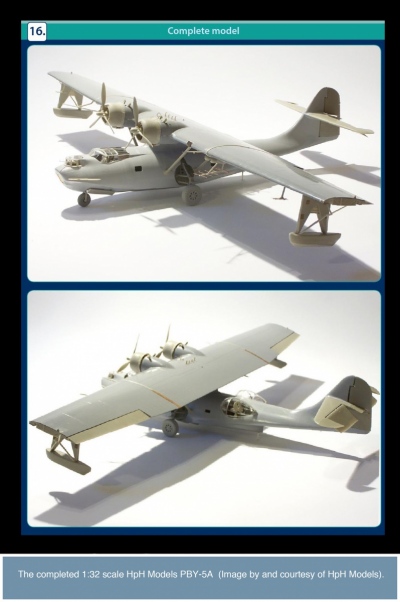HpH Models 32021L PBY-5A Catalina –1:32 Scale
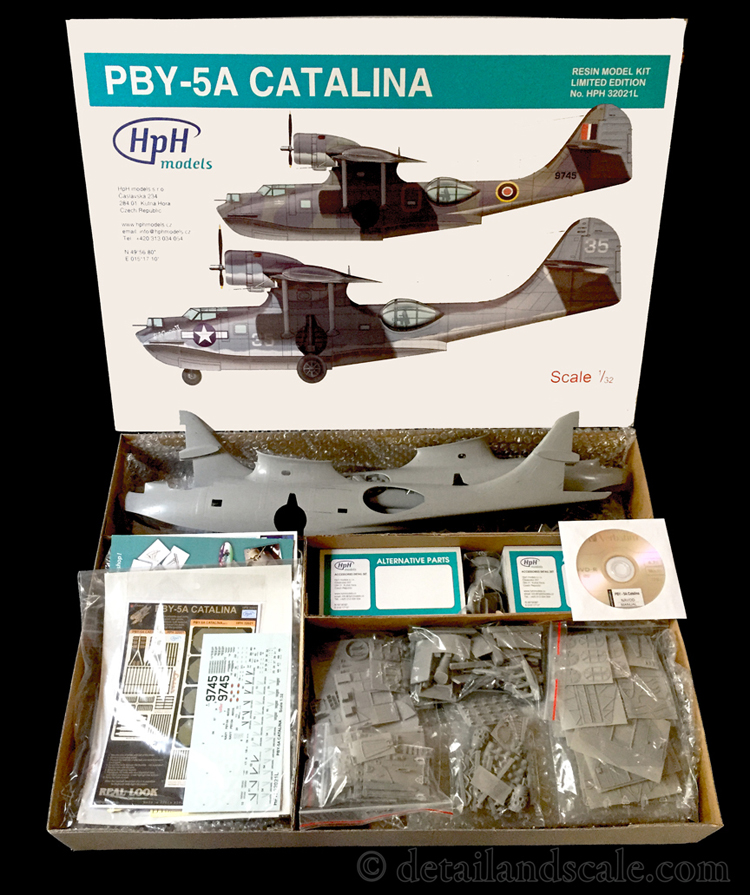
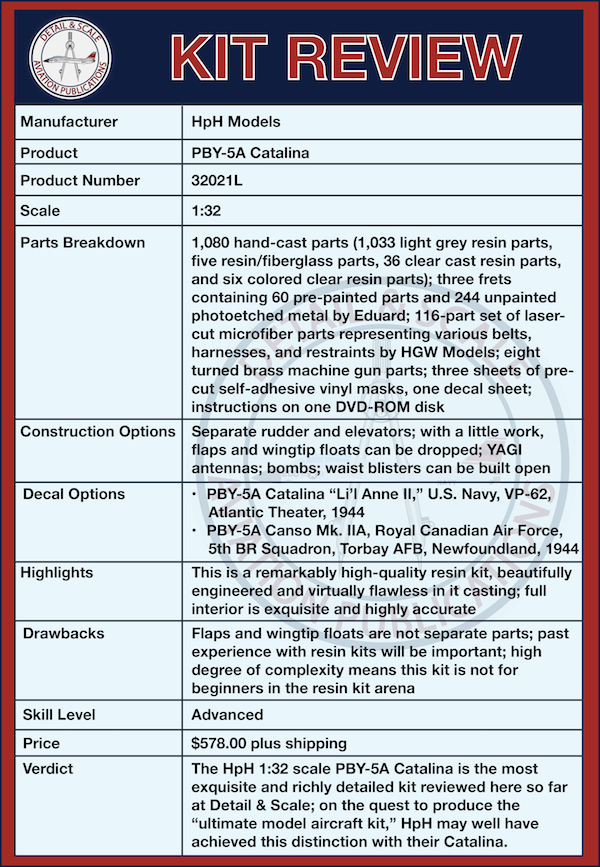
The concept of flying boats or amphibious aircraft emerged not long after the dawn of powered flight, but decades would pass before technological developments made the concept truly viable. Of all the storied century seaplanes of the 20th century, the Consolidated PBY Catalina is perhaps the most legendary of them, all as it served during the Second World War and beyond in a variety of distinguished roles. The Catalina has been the subject of a good number of injection molded plastic kits over the years, but the most extraordinary kit of the Catalina is HpH’s 1:32 scale PBY-5A. Its size notwithstanding, this kit also ranks among the most extraordinary scale aircraft model kits ever produced. Let’s take a look at this remarkable big-scale Catalina.

The rise and expansion of Japan in the 1930 into the Pacific demonstrated various shortcomings of American naval air power. In particular, the Navy’s flying boats of the era, Consolidated’s P2Y and Martin’s P3M, were both underpowered and suffered from short range and limited payload capacity. In this era, seaplanes filled variety of strategic, tactical, transport, liaison, search-and-rescue, and patrol roles. The War Department and the Navy thus decided to place a very significant investment in a new seaplane, even as the Great Depression was crippling the economy. Consolidated and Douglas were awarded contracts for a single prototype of the new seaplane.
Consolidated’s XP3Y-1 first flew on 28 March 1935. The airplane featured a two-step hull paired with a parasol wing mounted on a centerline fuselage pylon. Wingtip stabilizing floats were retractable to reduce drag. It was powered by two 825 hp Pratt & Whitney R-1830-54 Twin Wasp radial engines mounted on the wing’s leading edge. The engines allowed for some 2,000 lbs of bombs and other gear to be carried. While the Douglas entry into this competition was well regarded, the XP3Y-1 won the contract as Consolidated was able to get the unit cost down to $90,000 per aircraft.
The XP3Y-1 represented a major improvement upon the performance of previous flying boats, and soon, the Navy requested its further development as a patrol bomber, and the XPBY-1 was the result. Among other changes, the tail was redesigned to solve the intermittent problem of the tail becoming submerged on takeoff. The XPBY-1 first flew on 19 May 1936 and set a record distance of 3,443 miles on that first flight. Named as the Catalina, deliveries to the U.S. Navy (and later Great Britain) began in 1936.
Over the next several years, the Catalina was progressively upgraded, from the PBY-1 to the improved PBY-2, -3, and -4, built in production runs between 30 and 60 airframes each. With the advent of WWII, production of the PBY-5 took off with more than 680 constructed. The most numerous Catalina was the PBY-5A with over 800 built by May 1945. While other versions could be fitted with beaching gear, the -5A was truly amphibious. It incorporated a retractable tricycle landing gear based on a design by none other than Leroy Grumman. Its two Wright 1830-92 powerplants provided 2,400 hp; along with the B-17, the Catalina featured one of the longest ranges of any multi-engine airplane of the era until the B-29 came along.
Before the United States entered WWII, Catalinas proved to be genuinely versatile conducting a variety of missions including coastal neutrality patrols. The high wing provided observers particularly excellent visibility as a patrol and search-and-rescue platform. British Catalinas (known as the Canso in English Service) were however already at war, and in May 1941, one of their PBYs fist spotted the German battleship BISMARK, and the subsequent attack by the Royal Navy sunk this feared icon of German naval superiority. During the attack on Pearl Harbor, PBYs parked at Hickam AAF were targeted and very hard-hit since the Japanese did not want Catalinas looking for them as their carriers made their escape.
Later at the Battle of Midway in June 1942, Catalinas found the Japanese fleet steaming towards the island outpost – and that sighting set into motion a series of events that was beginning of the turning point in the Pacific theater. In the Atlantic, PBYs hunted German U-boats. USN, British, and Australian PBYs also excelled at nighttime attack, anti-shipping, and naval interdiction throughout the Pacific. Following the sinking of the USS INDIANAPOLIS, surviving sailors were found by a Catalina. When there was no more room inside for survivors, sailors were put on atop the wings and the seaplane served as a lifeboat from until rescue forces arrived. Following the war, Catalinas flew on with the Navy, USAF, and air arms of 28 other nations. Others made their way into private hands, and today, a small number still fly. Of course, for an airplane with such a rich history, this summary can barely do justice, and I recommend Rosco Creed’s (1984) book, PBY: The Catalina Flying Boat, Andrew Hendrie’s (1988) Flying Catalinas: The Consolidated PBY Catalina in World War Two, and Black Cats and Dumbos: WWII’s Fighting PBYs by Mel Crocker (1987).

HpH’s Catalina kit is the only kit of its kind in 1:32 scale, and it represents a PBY-5A. The kit consists of 1,080 hand-cast parts (1,033 light grey resin parts, five resin/fiberglass parts, 36 clear cast resin parts, and six colored clear resin parts). Also provided are three frets of photoetched parts manufactured by Eduard, consisting of 60 pre-painted parts and 244 unpainted photoetched metal parts. HGW Models also contributed a 116-part set of laser-cut microfiber parts representing various belts, harnesses, and restraints. Master Details contributed eight machined brass machine gun parts. Four sturdy, large-diameter metal pins that anchor the outboard wings sections into the center span round out the parts count. Most of the airframe markings and stencils are represented on a single decal sheet, but precision pre-cut masks are provided for the very large national insignias and a complete pre-cut masking set for all the clear parts. The 68-page instruction manual is provided as a PDF file and as JPEG images on a single DVD-ROM.
Markings are provided for two PBY-5s:
- PBY-5A Catalina “Li’l Anne II,” U.S. Navy, VP-62, Atlantic Theater, 1944
- PBY-5A Canso Mk. IIA, Royal Canadian Air Force, 5th BR Squadron, Torbay AFB, Newfoundland, 1944
Strengths: The HpH 1:32 scale Catalina kit is, in a word, stunning. Now that I have had an opportunity to spend time with this kit and critically examine it, I am moved to being mesmerized. I don’t know how many thousands of kits I’ve looked at over the last 35 years or so I’ve been building model airplanes, but I think this kit just might be the most extraordinary kit I’ve ever laid eyes on…and that includes comparisons with kits such as the rather spectacular museum-grade Hasegawa 1:16 scale Sopwith Camel or other jaw-dropping large-scale kits from HpH such as their 1:48 scale XB-70. This kit is a thing of beauty… and its beauty is only matched by its high degree of complexity. More on that later.
Getting the obvious observations out of the way: in 1:32 scale, the Catalina is big. The fuselage measures approximately 24 inches from front to back, while her great parasol wing spans 38 ½ inches. Casting quality throughout is nearly flawless. Starting with the fuselage: the entire left and right sides of the hull is split into left and right halves, and if I’m not mistaken, there’s a layer of pressed fiberglass sandwiched between the inner and outer surfaces of the hull. Surface detail is exquisite with very high-fidelity recessed panel lines and rivets, and where appropriate, raised detail, too. The wing comes in three pieces: a center span and the port and starboard outboard wings. While cast as upper and lower halves, HpH has glued them together and gotten the modeler’s work started for us. To keep these parts lightweight but rigid, there’s a fiberglass mesh on the interior surfaces. Wing surface detail is equal to that of the fuselage, and the molded texture of the fabric-covered control surfaces is just sublime. Shape, proportions, and sizes appear to really capture the Catalina with great accuracy. Test fitting between the fuselage halves and wing components showed great alignment and fit for a limited run kit of this variety.
The most complex, beautiful, and exquisitely made portion of this kit is its interior. The HpH Catalina features a FULL interior. Having been a student of this airplane for some time, I don’t think there’s anything HPH missed. Even the subtle things that you might forgive a kit manufacturer for missing are all there – and appear just perfect, such as the small latrine, bilge pumps, fire extinguishers, watertight door details, and relief on the various compartment bulkheads. While the interior stringers and ribs and separate pieces, there’s really no other better way to represent these raised interior surface details. It’s all there, and again, the fidelity of detail is stunning (see photos at the bottom of this review). Some of that comes in the form of the many superbly hand-cast resin parts. The resin parts are directly complimented by the amazing Eduard photoetched metal parts. Master Detail’s multipart machined brass gun barrels, with a separate cooling jacket surrounding the barrel, replicates the 1:1 scale machine gun exactly (seriously, what a nice design consideration!).
All of this detail means that the scale modeler has the opportunity to make this Catalina detailed in ways that will supersede any other model they’ve ever built. Building the PBY’s interior will be a very immersive experience. There’s also a LOT going on here, and it will be time consuming, from doing your own research, careful study of the detailed instructions, parts preparation, and test fitting. So, take your time and enjoy this.
The bow gunner/bombardier position and the cockpit really comes alive with its combination of the high-fidelity resin details, Eduard photoetch parts, and the HGW Microfiber belts. Things things get more impressive as you move aft, starting with the navigator and radio operator’s stations. These stations are beautifully executed and the Eduard pre-painted radio faces are a welcome feature. Other details, such as the navigator’s drift sight, sextant, and (very analog) computer are provided in the Eduard frets and can be placed on the navigator’s workstation. Aft of this is the crew compartment featuring the crew bunks, and interior main wheel wells, and elevated observer’s station who peered out the small windows in the fuselage center pylon. Then, it’s on to the waist gunner positions and the downward firing tail gun. Once again, the detail here appears to be perfect. The only thing a scale modeler could add are control lines and wiring bundles.
Both of the Pratt and Whitney powerplants are complete kits in and of themselves, and all you have to do is add ignition wires. They are small works of art in this scale, from the crank case to the cylinder heads ignition rings, exhaust pipes, and accessory gear. Cowl flaps, however, are molded only in the open configuration.
The elevators and rudders are cast as separate pieces and can be positioned as the scale modeler desires. Underwing stores include four bombs (they look to be of the 250-lb. variety) as well as a pair of YAGI antennas. The clear parts, ranging from the big canopy to the waist bubbles, are exemplars in casting of clear resin. Their optical quality is excellent and I can see no discernable defects, but increasing their shine with a coat or two of Johnsons Pledge (Future Floor Wax) is advisable. The decal sheet is very nicely printed. Colors look great, everything is in register, and carrier film is nicely restrained. The pre-cut masks are flawless. The instructions are very clearly rendered with excellent photography. Moreover, the construction step breakdown renders a very complex build into very manageable steps, and I think that is key for a build of this intricacy.
Weaknesses: A few minor things to consider while building this kit. These are far fewer weaknesses and more observations to keep in mind. First, be mindful of the fact that this kit is for advanced scale modelers, and past experience with resin kits will be important. Second, the fuselage and wings contain fiberglass. While it’s always advisable to have some kind of respiratory protection when working with resin dust, fiberglass dust can be an even greater irritant, so one should take some extra precaution when cleaning up and sanding the seams on the fuselage and wings.
Third, thoughts about weight: the kit should be nose heavy, but I always worry about center-of-gravity and tail-sitters. The instructions don’t call for any added nose weight, and I am not sure where one could hide it if they had to add anything; this may be a moot point. The main gear look to be sturdy enough, and they just as other weight-bearing parts (e.g., wing pylons), they are cast around an internal metal armature that looks like steel to me. This gives me confidence, and I assume HpH more than thought about the strength of their landing gear to support the weight of the completed model. Though for me, I still might choose to fabricate some kind of jig to set the model in when it’s not on display, just to be extra cautious.
Fourth: on my review sample, there was some chipping on trailing edge of the wings, and they will require some extra filling, sanding, and re-contouring, but it won’t amount to a lot of work. In casting the wings, it was a lot easier for HpH to cast a complete wing, so in order to either drop the flaps or lower the wingtip floats (which are indeed construction options), cutting will be required. Again, a little more work, but it’s not at all hard.

I’ve had the privilege to review many great kits here at Detail & Scale, but I think the HpH 1:32 scale PBY-5A Catalina kit is the most exquisite and richly detailed that I’ve ever seen. This kit is a work of art from the point-of-view of resin kit manufacturing. For me, it’s become a “bucket list kit,” of which I surmise I will build only one in my lifetime and that will be a matchless and memorable experience. It will also be long-term build, and will no doubt test my abilities and help me build new skills, too. I also plan on a “practice run” building the ProModeler 1:48 PBY-5A with the Eduard BigEd photoetched metal set before I tackle this beauty. On the quest to produce the “ultimate aircraft model kit,” HpH may well have achieved this distinction with their Catalina. Congratulations are owed to HpH for this achievement, and I look forward to building this kit like no other project has inspired me for a long, long, time.
Sincere gratitude is owed to HpH Models for the review sample. You can find them on the web at http://www.hphmodels.cz/hph/?lang=en and on Facebook at https://www.facebook.com/hphmodels/. You can also contact them by email at info@hphmodels.cz
Haagen Klaus
Scale Modeling News & Reviews Editor
Detail & Scale


